Even after a decade, my self-driving car predictions haven’t changed. The path to wide adoption hasn’t come as fast as many “experts” predicted. Here’s a realistic timeline of what you can expect with autonomous vehicles.
Self-Driving Car Predictions
I shared a video with these predictions as well. Feel free to check it out, along with more insights below.
I’m 32 and in my lifetime, I won’t be able to drive a car on some highways. That’s because governments will start to only allow self-driving cars.
Similar to riding a horse, you can still do that today, but not on most major roadways. There will always be a market for manual driving, similar to riding horses. But for most, self-driving cars will be the best option. Now, the key question, how long will this transition take?
When Will Self-Driving Cars be Widely Adopted?
About a decade ago, I dived into researching self-driving cars. That was from more of an investment standpoint. And at that time, some “experts” were claiming that it’d only take five years. But I believed that was way too optimistic.
At that time, I predicted it’d take close to 30 years for wide adoption of autonomous cars. So, about 20 more years from today. And based on the trends, I’m sticking to that early prediction. But there are a few big keys to understanding this…
By wide adoption, I mean over half the cars on the road will be fully self-driving. The first key to understanding this is that the average car life expectancy is roughly 12 years. So, once every new car that’s sold is self-driving, it’d take about another 12 years to replace most of the existing fleet on the roads.
Limitations of Self-Driving Cars
There will be plenty of speed bumps, pun intended 🙂 But technology and costs won’t be the main barriers. Not directly, at least… You can buy a new Tesla Model 3 for close to $40,000 today (and that drops to $30,000 with tax credits and gas savings). It’s the lowest cost it’s ever been (inflation adjusted). On top of that, these new cars have improved full self-driving hardware and software. Here’s the full Model Y Price History as well.
Now, there’s a long tail of driving situations to solve. For example, plenty of bad weather conditions. Or weird objects falling off other cars.
… but already, Tesla has solved roughly 99% of driving time. And some other autonomous driving companies might be ahead such as Waymo. Although, most competitors are geofenced with different sensor suites that include lidar. But either way, it’s now a march of the nines, which are exponentially more difficult to solve.
By that, I mean solving the next 0.9% of self-driving might take a similar amount of effort as the first 99%. And so on… but human drivers aren’t 100% fault proof.
Tesla full self-driving is clumsy, but is it already safer than the average human driver? Most of the data I can find, puts it close today. It depends on the driving situation. And in a few more years, along with more data in the door, it should be clearly better.
What’s Stopping Self-Driving Cars?

Technology and costs aren’t the big barriers. Instead, the main barriers to full self-driving come from public perception, regulatory changes and certain special interest groups.
For example, it’ll have a huge impact on the car insurance industry. Premiums will drop and claims should drop as well, but that’s less float for insurance companies to invest. This also delays car manufacturers’ full switch to self-driving. By the driver always having to pay attention and be ready to take over, it keeps liability on the driver’s side.
Even with Waymo expanding to new cities, remote supervision will be a default for years to come. And over at Tesla, Elon Musk has continued to be overly optimistic on full self-driving timelines. Its robotaxi event, We, Robot, gives an optimistic timeline for souped-up Model 3s and Ys to give self-driving taxi rides in late 2025. Then in 2026, we might see dedicated Tesla Robotaxis without steering wheels.
How Self-Driving Cars Impact Ownership
No matter the timeline, we’re well along the way. And the benefits of self-driving cars will far outpace the negatives. I’ll leave you with one more big self-driving prediction…
Car ownership will drop faster. The American dream of owning a home and a car is changing. Already, car ownership peaked close to 20 years ago.
The average family in the U.S. owned 2.05 cars in 2006. Since, it’s come down and is closer to 1.9 cars per household today. I’m predicting it’ll decrease at a faster rate as self-driving cars become common. Ride sharing will become even more accessible and cheaper per mile. One of the most expensive pieces to your Uber ride is the human driver. And driverless cars will replace them.
I can do a deeper dive into the logic behind my autonomous car predictions. Overall, many people overlook what’s about to change. Here are some highlights…
Pros and Cons of Self-Driving Cars
The pros of self-driving cars will far outweigh the cons. However, both are useful to consider. Here are the top for both…
- Save 1.3 Million Lives Each Year
- Boost Productivity and Reduce Stress
- Lower Travel and Insurance Costs
We’re already starting to realize many of these benefits. That’s thanks to improved driver assistance and safety features. For a full list of benefits, here are 17 Benefits of Self-Driving Cars. Now, on to the downsides…
- Wipes Out Over 5 Million Jobs
- Increased Cyber Threats
- Reduces Driving Freedom and Skills
For a full list of Cons of Self-Driving Cars, check out that article. There’s a lot to consider as our transportation changes. These self-driving car predictions are more realistic than most. If you have any comments, feel free to reach out directly or comment on any of my YouTube videos.